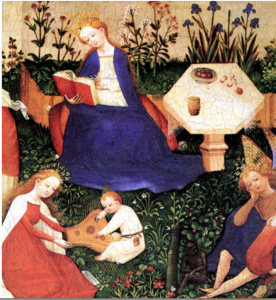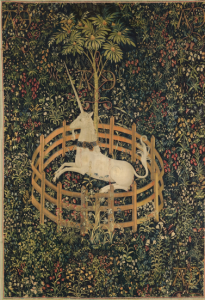Great Lawn
I want to rip up our boring lawn and replace it with a flowery mead, the carpet of tiny flowers you find in Medieval paintings and 15th century tapestries. The smallest blooms—birdsfoot trefoil, thyme, hawkbits, ladies’ bedstraw, self-heal, cowslip, viola, violets, periwinkle, lily of the valley and columbine—were just some of the millefleurs that made up these idealized meadows. And the cultivated spot made the perfect setting for a turf seat, a bench covered with the softest grass.
The Metropolitan Museum of Art’s “Unicorn in Captivity” gives a good example of what I’m going for. (This tapestry also inspired the Encyclopedia‘s entry on unicorns.)



Such a novel idea. The Garden Museum in London has a wonderful example of an Elizabethan knot garden. It’s a wonderful, quirky museum loacted in a splendid medieval church next to Lambeth Palace and across from the Houses of Parliament. I had my wedding reception there a couple of years back and fell in love with it! Loving the blog xx
http://www.gardenmuseum.org.uk/ourgarden/knot_gardens.html
The knot garden is sublime! Your wedding must have been the same. Thanks for the link. I am going to visit the Garden Museum on my next trip to London. xxx
I’m an art history student at the Medieval Institute of Fordham University and I think that your flowery mead idea is great! Mixed lawns so much better for plant and animal biodiversity and soil fertility than monotypes like lawn grass. Have you considered using North American natives in the place of European species? I have a great book – L’Ivre des Prouffits Champestres et Ruraulx by Piero de’ Crescenzi (Livre des Proffits Ruraux in modern French) that’s a garden manual by a fourteenth century lawyer/dilettante. If you want to hear about Medieval gardens from the horse’s mouth, Piero de Crescenzi is your man.
Happy gardening!
Dear Scott,
This is so exciting! I can’t wait to check out Piero de Crescenzi.The book sounds wonderful. Thanks for writing.
Jessica
[…] Lawn Reform is quite a hot topic in the landscape industry, particularly in areas (not New England) where extreme amounts of water are required to keep the grass alive and healthy. Here in my corner of the world, properly planted and cared for established lawns generally don’t need more water than mother nature provides, but an issue of a lack of diversity can come into play as well as a plain lawns often lack design interest. I am a fan of the weedy lawn, not completely for environmental reasons, but simply because I like the notion of a medieval flowery mead (meadow) and they are simply beautiful! Lawn perfection is about the most snooze-inducing thing I see in American suburbs and I love it when I see a beautifully cultivated mead. The Metropolitan Museum of Art’s “Unicorn in Captivity” found at Encyclopedia of the Exquisite. […]